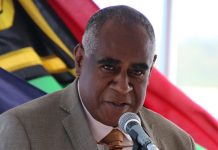The United States military test-launched an unarmed, but nuclear-capable, intercontinental ballistic missile from California over the Pacific Ocean on Tuesday.
The Minuteman III ICBM was fired at 11:01 pm Pacific Time from the Vandenberg Space Force Base in California during an operational test. The U.S Space Force said the test showed the nation’s ICBM fleet can leverage dominance in an era of strategic competition.
Strategic competition is defined by the White House as the U.S prioritising maintaining an enduring competitive edge over China while constraining a “still profoundly dangerous” Russia. These three nations are among the nine countries armed with nuclear weapons.
The test demonstrated what the airmen “bring to the fight if called by the president,” General Thomas A. Bussiere, commander of the U.S Air Force Global Strike Command, said in a statement.
The Louisiana-based command, which controls and operates the Minuteman III, said the test was a “routine and periodic” activity, which aimed at demonstrating the country’s nuclear deterrent “is safe, secure, reliable, and effective” to deter threats and reassure allies.
It was the fourth nuclear missile test in the Pacific Ocean since 25 September, when China fired a DF-31AG ICBM to the South Pacific. On 29 October, Russia said it test-launched an RSM-56 Bulava submarine-launched ballistic missile (SLBM) over the Sea of Okhotsk.
Two days later, North Korea held a test launch of the new Hwasong-19 ICBM to the East Sea, also known as the Sea of Japan. This missile, which is the North’s largest ICBM to date, is estimated to be capable of flying over 9,320 miles and striking the U.S mainland.
“Such tests have occurred over 300 times before, and this test is not the result of current world events,” the U.S Air Force Global Strike Command added. It explained that the test was scheduled “years in advance” and was the culmination of months of preparation.
After launching from California, the missile’s multiple targetable re-entry vehicles, which are the payload for carrying nukes in operational status, traveled 4,200 miles westward to a test site located within the Marshall Islands at the Kwajalein Atoll in the Central Pacific.
The Minuteman III, which has a range of more than 6,000 miles, is deployed with a single nuclear warhead. However, it can carry up to three multiple targetable re-entry vehicles, allowing each missile to strike different targets on the ground with multiple warheads.
There are currently 400 Minuteman III missiles deployed at the F.E Warren, Malmstrom and Minot air force bases, where their hardened silos are located across five states. They will be gradually replaced by the Sentinel, the U.S’ next generation ICBM, as early as 2029.
Another feature of the test was the Airborne Launch Control System (ALCS), an alternate ICBM launch method. It allows the U.S Navy E-6B Mercury aircraft to issue the launch command to the missiles if the command centres on the ground are unable to do so.
The Minuteman III has been test-launched with more than one re-entry vehicle. The most recent such test occurred in September last year with three re-entry vehicles. The ALCS was tested before as well, when the E-6B Mercury initiated the launch in April that year.
The U.S military tests its ICBM fleet about four times a year, but not all tests end successfully. On 01 November 2023, an anomaly occurred during a test launch from California, and an unarmed Minuteman III was thus terminated over the Pacific Ocean.













